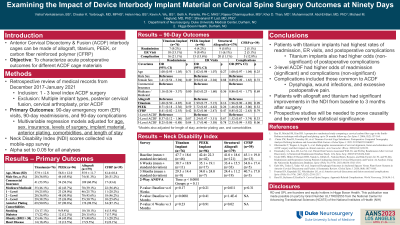Comparing the Effect of Implant Material on 90-Day Outcomes in Anterior Cervical Fusion Surgery
Comparing the Effect of Implant Material on 90-day Outcomes in Anterior Cervical Fusion Surgery
Friday, April 21, 2023


Vishal Venkatraman, BS (he/him/his)
Medical Student
Duke University
Durham, North Carolina, United States
ePoster Presenter(s)
Introduction: Structural allograft, titanium, polyetheretherketone (PEEK), and carbon fiber reinforced polymer (CFRP) are all interbody implant options for anterior cervical discectomy and fusion (ACDF). Studies have analyzed long-term clinical and radiographic outcomes and we sought to characterize acute postoperative outcomes for different implant types.
Methods: Patients who underwent 1, 2, and 3-level primary ACDF and had at least 90 days of postoperative follow-up were reviewed retrospectively. Patient demographics, 90-day postoperative readmissions, ER visits, and complications were all recorded. The Neck Disability Index (NDI) responses were gathered. The odds of each 90-day outcome were calculated using logistic regression, which took into account age, gender, insurance, length of hospital stay, comorbidities, surgical levels, use of anterior plating, and implant material.
Results: There were 390 patients included, of which 179 received allografts, 76 titanium, 96 PEEK, and 39 CFRP. The average age was 57.1±12.0 and 166 (42.6%) were male. The 90-day readmission rate was 9.2% for titanium, 4.2% for PEEK, 5.0% for allografts, and 5.6% for CFRP. The ER rate was 13.1% for titanium, 9.4% for PEEK, 6.1% for allografts, and 5.1% for CFRP. The complication was 21.1% for titanium, 15.6% for PEEK, 11.1% for allografts, and 12.8% for CFRP. In the multivariable models, there were no significant differences between implant types. The average NDI decreased from baseline to 3 months post-surgery with titanium (47.7 to 29.3, p=0.0081) and allografts (41.0 to 18.6, p=1.4E-6), but not with PEEK or CFRP.
Conclusion : This study compared acute outcomes between structural allograft, titanium, PEEK, and CFRP implants placed during elective ACDF. Patients receiving allografts and titanium had significant reductions in NDI scores and a combination of objective and subjective improvement in short-term clinical outcomes.
Methods: Patients who underwent 1, 2, and 3-level primary ACDF and had at least 90 days of postoperative follow-up were reviewed retrospectively. Patient demographics, 90-day postoperative readmissions, ER visits, and complications were all recorded. The Neck Disability Index (NDI) responses were gathered. The odds of each 90-day outcome were calculated using logistic regression, which took into account age, gender, insurance, length of hospital stay, comorbidities, surgical levels, use of anterior plating, and implant material.
Results: There were 390 patients included, of which 179 received allografts, 76 titanium, 96 PEEK, and 39 CFRP. The average age was 57.1±12.0 and 166 (42.6%) were male. The 90-day readmission rate was 9.2% for titanium, 4.2% for PEEK, 5.0% for allografts, and 5.6% for CFRP. The ER rate was 13.1% for titanium, 9.4% for PEEK, 6.1% for allografts, and 5.1% for CFRP. The complication was 21.1% for titanium, 15.6% for PEEK, 11.1% for allografts, and 12.8% for CFRP. In the multivariable models, there were no significant differences between implant types. The average NDI decreased from baseline to 3 months post-surgery with titanium (47.7 to 29.3, p=0.0081) and allografts (41.0 to 18.6, p=1.4E-6), but not with PEEK or CFRP.
Conclusion : This study compared acute outcomes between structural allograft, titanium, PEEK, and CFRP implants placed during elective ACDF. Patients receiving allografts and titanium had significant reductions in NDI scores and a combination of objective and subjective improvement in short-term clinical outcomes.
